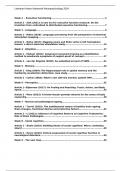Samenvatting
Summary of articles advanced neuropsychology
- Instelling
- Universiteit Utrecht (UU)
This document provides summaries for weeks 2 through 7, covering the articles assigned for the lectures and exam preparation. Some specific results and details are excluded, as they may not be essential for the exam. Please note that the summaries for weeks 8 and 9 are not included.
[Meer zien]





